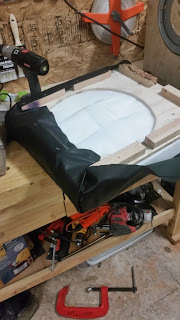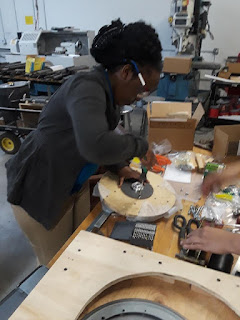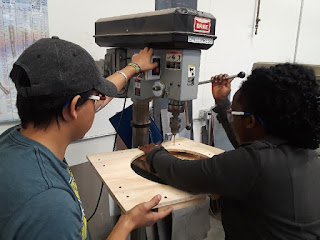Testing and
Verification Plan
Requirement: Must not induce
over 33 mmHg on arteries for more than 1 hour; Must mitigate relative pressure
against the bony prominences in the buttocks (sacrum/ischium). Pressure distribution
must alternate to allow regular tissue decompression. Maximum pressure
at the ridge must not exceed 10% of the user’s body weight per square centimeter. Minimum
pressure at the decompression areas must not exceed 5% of the user’s body
weight per square centimeter.
Test
Procedure: A flexible pressure pad connected to a computer will be placed
between the operating device’s cushion and a seated test user. The pressure at
the cushion interface will be measured, specifically the ridges as they turn
under the bony prominences. The pressure pad’s sensor precision must be
experimentally verified by comparing the sum of each sensor’s pressure * total
area to the expected weight across the device’s surface.
Requirement: Device should
provide a fan-like pressure gradient which accommodates fluid flow in vascular
tissue near the cushion interface. Must generate non-zero flow through surface vascular
tissue while disc is turning.
Test
Procedure: A tissue-like gelatin material will be impregnated with horizontal
layers of radially oriented ductile plastic tubing filled with water and marker
particles. The marker particles will be set at the outer edges of the tubing. The
gelatin model will be placed on the disc with at least 150 lb. of weight across
its top surface. The device will be turned on and allowed to run for up to 2
minutes. Net particle movement will act as a measure of flow. Non-zero flow
toward the center of the disc is the goal.
Requirement: Device should be
comfortable.
Test
Procedure: The cushion interface pressure gradient test quantitatively fulfills
this requirement. Qualitative feedback from users will also be considered.
Requirement: Device weight
should not exceed 50 lb.
Test
Procedure: Prototype (without its display base and battery) will be weighed
and final prototype materials and design may need to be altered.
Requirement: Device dimensions
must not exceed 42x36x26 in.
Test
Procedure: Prototype (without its display base and battery) will be weighed
and final design may need to be altered. Note that the device’s dimensions are
already adjustable for various seat sizes.
Requirement: Cushion must
regulate contact heat and humidity at cushion interface.
Test
Procedure: Heat and vapor dissipation testing protocols are defined in
RESNA/ISO standards. If a pre-approved wheelchair cushion and seat cover are
being used, this requirement has already been verified and does not need to be tested.
Requirement: Device must be able to withstand 200 lb. across its seat surface.
Test
Procedure: Calculate the load response of the device in its final
fabrication material using available experimental material information. Material
must be able to handle prescribed loading with a minimum safety factor of 1.5
Requirement: Wheelchair range must not be reduced by more than 40%.
Test
Procedure: Calculate device power draw for specific wheelchairs on the
market and in current use. If a battery upgrade is required to fulfill this
requirement, its description (make, cost, size) must be included in test
results.
Another New Base Created
On Monday, our team decided to create new base due to the disc not moving.
The pictures below show the team working on a new base to center the motor.
The figure above shows our teammate creating the holes on base for the turntable using a drill press
The figure above shows one teammate using a jigsaw to create a cut for flange collar access
The figure above shows the motor and disk connected as a whole
The figure above shows a teammate using a hack saw to cut the machine screws that were slightly longer (1/4-20-4" to 3-1/2)
The figure above shows a teammate fastening the turntable on the base with wood screws
Although, the team created a new base, the disk was not turning as expected. There was issues with the alignment.
On Tuesday, the team decided to create another base. Our team spoke to our adviser and the team determined that the shaft of the motor needed to be centered to the center point of the turntable to have the disc turning accurately.
The figures below show how the team accurately measured the turntable to its center point in order to place the shaft of the motor correctly.
The figures above how the center point of the turntable was measured.
The figure shows how the points at the end of the circle were accurate, therefore, having the center of the turntable
The figure above shows machine screws being placed to get accuracy on where the motor is aligned.
























































